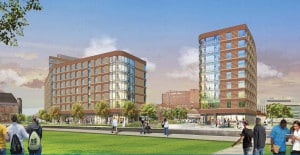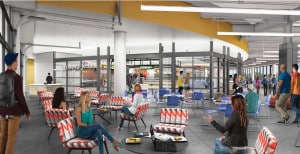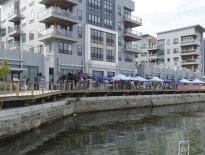
Capstone Development Partners is partnering with University of Massachusetts-Boston on construction of more than 1,000 dorm beds in two on-campus buildings.
The city of Boston has staked out the ambitious goal of building 18,500 new college dorm beds by 2030, as part of the Hub’s ongoing effort to ease its housing shortage by getting students out of private rentals and into campus residence halls.
But is it really as ambitious as it appears? Perhaps not.
In its recently released “Boston 2030” master plan, the city set a goal of 16,000 new dorm beds within 13 years – or 18,500 if graduate-student housing is included.
“We need to take the students out of workforce housing to free it up for others,” said Devin Quirk, director of operations for Boston’s Department of Neighborhood Development.
In the end, the goal is to reduce by 50 percent the 13,000 students now renting in either single-family homes, apartment buildings or Boston’s classic triple-decker buildings in neighborhoods strewn across the city.
Until last year, the city was adding only about 500 new dorm beds per year, or roughly 2,600 from 2011 through 2015. At that annualized pace of construction, the city would add only about 6,500 dorms by the time 2030 rolls around in 13 years, far short of its long-term goal.
In 2016, however, the city saw 1,000 new dorm beds come on line across the city – and, if that pace is kept up, the 2030 goal is suddenly more feasible.
Quirk is guardedly optimistic the city can hit both the 16,000 undergraduate and 18,500 undergrad-and-grad bed targets – and that’s because the current pipeline for new college dorm beds is strong and makes last year’s impressive performance seem less like an anomaly. The current pipeline of 10,000 additional new beds includes dorms already under construction, approved for construction, under design review or stipulated within schools’ long-term master development plans.
Combined with the new dorm beds that have opened since 2011, the city is theoretically within striking distance of achieving the goals set in the Boston 2030 report, Quirk said.
“We definitely need to accelerate construction in coming years,” Quirk emphasized. “There will be up and down years, but we think (the goal) is achievable.”
A Numbers Game
Rich Giordano, director of policy and community planning at the nonprofit Fenway Community Development Corporation, praised the Walsh administration for aggressively pushing new dorm construction. The policy that was first initiated under Walsh’s predecessor, the late Mayor Thomas Menino.
“We’re really happy to see the mayor committed to this,” Giordano said. “But the devil is always in the details.”
If schools increase their overall enrollment over coming years, then new dorm construction won’t make much of a difference on the housing market, since a higher number of overall students would partly offset any new dorm construction.
Then there’s the issue of exactly what constitutes future dorm construction.
Giordano noted that Northeastern University recently partnered with American Campus Communities (ACC) to build rental apartments for a total of approximately 820 residents on a parcel of land owned by Northeastern at 10 Burke St. That project is now under construction.

Capstone Development Partners and University of Massachusetts-Boston are partnering on the school’s first-ever on-campus residence halls scheduled for completion in fall 2018. The 260,000-square-foot, two-building project will include dorm rooms ranging from single-occupancy to four-person units, seminar rooms, study lounges and a 23,000-square-foot dining hall.
But Northeastern earlier this year informed the city that it wasn’t guaranteeing that all those new residences will be leased by its students, calling into question exactly how many dorm beds should be counted, according to city records.
A similar university-private developer partnership is under way at the campus of the University of Massachusetts-Boston, where Capstone Development Partners is currently constructing more than 1,000 dorm beds within two separate buildings on campus.
UMass-Boston is committed to leasing all of that dorm space, making the complex the university’s first-ever on-campus residence hall – albeit one that’s owned, operated and managed by a private entity.
Kevin Sullivan, vice president of Boston-based Shawmut Design & Construction, which is handling construction for Capstone, said he expects to see similar public-private dorm partnerships moving forward. They’re especially attractive alternatives to schools, both private and public, that don’t want multimillion-dollar capital projects on their books, he said.
The UMass-Boston/Capstone complex – which includes a dining hall and common live-and-learn spaces for students – is expected to open next year. A topping-off celebration was held earlier this month.
Besides UMass-Boston, Shawmut is also involved in various dorm-related projects at Harvard, Worcester Polytechnic Institute and other regional colleges, said Sullivan, noting that there’s increasing demand by students and their parents for higher-quality student residences across New England and the country.
Quirk said the city of Boston is determined to keep the pressure on schools to provide enough housing for their students with the city of Boston. “We’re making progress,” he said of campus dorm construction.








